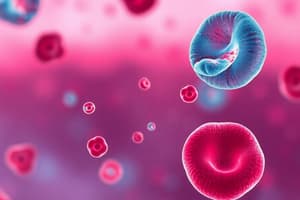Podcast
Questions and Answers
What is the key factor that determines whether hemolysis results in anemia?
What is the key factor that determines whether hemolysis results in anemia?
- Severity of jaundice
- Patient's age
- Rate of red blood cell destruction
- Bone marrow's ability to compensate for RBC loss (correct)
Which laboratory finding is the MOST indicative of hemolysis?
Which laboratory finding is the MOST indicative of hemolysis?
- Elevated white blood cell count
- Decreased hemoglobin levels
- Decreased reticulocyte count
- Elevated reticulocyte count (correct)
Which bodily change suggests hyperplastic marrow spaces due to hemolytic anemia?
Which bodily change suggests hyperplastic marrow spaces due to hemolytic anemia?
- Enlargement of the mandible and maxilla (correct)
- Thinner cranial bones
- Reduced bone marrow activity
- Increased bone density in limbs
What is the normal life span of a red blood cell (RBC)?
What is the normal life span of a red blood cell (RBC)?
What can cause accelerated destruction of RBCs related to environmental factors?
What can cause accelerated destruction of RBCs related to environmental factors?
What is a common clinical manifestation observed in the oral mucosa of patients with hemolytic anemia?
What is a common clinical manifestation observed in the oral mucosa of patients with hemolytic anemia?
In addition to pallor or jaundice, what other oral manifestation might be seen in a patient with hemolytic anemia?
In addition to pallor or jaundice, what other oral manifestation might be seen in a patient with hemolytic anemia?
What two general categories classify the causes of hemolytic diseases?
What two general categories classify the causes of hemolytic diseases?
Which result is NOT related to the three mechanisms for accelerated destruction of RBCs?
Which result is NOT related to the three mechanisms for accelerated destruction of RBCs?
Which of these characteristics is MOST indicative of a molecular defect inside the hemoglobin?
Which of these characteristics is MOST indicative of a molecular defect inside the hemoglobin?
Flashcards
Hemolytic Anemia
Hemolytic Anemia
Anemia resulting from the premature destruction of red blood cells, where the bone marrow cannot compensate for the loss.
Causes of Hemolysis
Causes of Hemolysis
Accelerated destruction of RBCs due to molecular defects, membrane abnormalities, or environmental factors.
Manifestations of Hemolysis
Manifestations of Hemolysis
Pallor/jaundice of oral mucosa, paresthesia, and hyperplastic marrow spaces in facial bones.
Reticulocyte Count
Reticulocyte Count
Signup and view all the flashcards
Study Notes
- Anemia occurs in hemolytic diseases when the bone marrow cannot replace prematurely destroyed red blood cells (RBCs).
- Normal RBC lifespan is 90 to 120 days.
- Hemolytic diseases can be inherited or acquired.
- Molecular defects inside hemoglobin or abnormalities in membrane structure and function can cause hemolytic diseases.
- Accelerated RBC destruction can occur due to environmental factors, such as mechanical trauma.
Clinical Manifestations
- Pallor or jaundice of the oral mucosa can be observed.
- Paresthesia of the mucosa may occur.
- Hyperplastic marrow spaces may be present in the mandible, maxilla, and facial bones.
Laboratory Findings
- An elevated reticulocyte count is a key indicator of hemolysis.
- Elevated reticulocyte count reflects erythroid hyperplasia of the bone marrow.
Studying That Suits You
Use AI to generate personalized quizzes and flashcards to suit your learning preferences.




